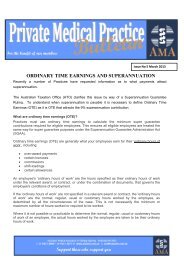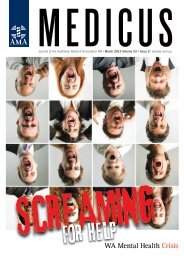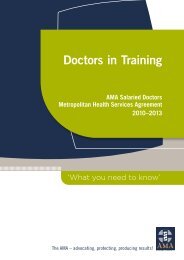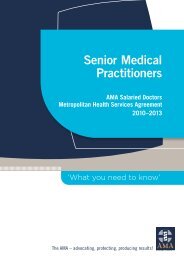twrama 1990_final oc.. - AMA WA
twrama 1990_final oc.. - AMA WA
twrama 1990_final oc.. - AMA WA
You also want an ePaper? Increase the reach of your titles
YUMPU automatically turns print PDFs into web optimized ePapers that Google loves.
COVER STORY<br />
Compassion is key<br />
26 MEDICUS October<br />
By Dr Alexandra Welborn - Psychiatrist, Royal Perth Hospital<br />
Member, Mental Health Advisory Council of the Mental Health Commission<br />
daily request of our Consultation Liaison Psychiatry<br />
A team at Royal Perth Hospital: “kindly assess this person<br />
who has attempted suicide by jumping…overdose…stabbing…<br />
cutting…burning…gassing…car crash…shooting…hanging”.<br />
Suicide is one of the constant sorrows of psychiatry, and its<br />
spectre is ever present in the minds and hearts of the clinicians<br />
working with troubled patients. Kindness is essential in the<br />
approach to patients who have harmed themselves. I have<br />
been asked to provide a clinical perspective on suicide for the<br />
readers of Medicus.<br />
Karl Menninger was an American psychiatrist who<br />
built his practice and a substantial legacy on the tenets of<br />
humanity, kindness and compassion for his patients. He<br />
sought understanding of the adverse early life experiences<br />
that contributed to patients’ difficulties. Menninger made<br />
the brilliant observation that suicidal patients may have three<br />
interlinking motivations. There is clearly the desire to die,<br />
but also present is the desire to be killed and the desire to kill<br />
(Menninger, 1938).<br />
Menninger’s beguilingly simple message provides a searing<br />
insight into the violence that is necessarily present in an<br />
attempt to end a life. Menninger’s understanding provides<br />
insight into both murder/suicides and patients who attempt<br />
suicide by enticing another to kill them, as is seen with those<br />
who set out to behave in such a way to be killed by police.<br />
Assessments for risk of suicide must therefore also include<br />
the assessment of the risk of homicide, and the risk of being a<br />
victim of homicide or accidental death.<br />
There are historical risk factors for completed suicide.<br />
Any previous suicide attempt is the single strongest risk<br />
factor for death by suicide (Hawton, 2005). A person who<br />
has made a previous attempt will then always carry this<br />
increased historical risk. Perhaps more useful are possible<br />
precipitants for suicide impacting on a person in the hours and<br />
minutes before their suicidal act. These include intoxication,<br />
interpersonal conflict, acute loss, shame and acute loss of selfesteem.<br />
Young people might be goaded to suicide by others<br />
on Facebook, Twitter and Tumblr. Precipitants are always<br />
intensely personal to the individual.<br />
Talking about suicide is sometimes difficult for nonpsychiatric<br />
colleagues, who may be concerned that bringing<br />
up the subject increases risk in suggestible patients. There is<br />
no evidence that speaking of suicide with patients increases<br />
their risk of acting.<br />
I tend to start with a question about thoughts – “Have you<br />
been troubled by suicidal thoughts?” This then progresses<br />
to exploring the presence of specific plans involving<br />
methods. This may require an interview technique called<br />
‘normalisation’, which implies that all people may have these<br />
thoughts from time to time. Closely observe the patient’s<br />
affective response when asking about methods. “Have you<br />
st<strong>oc</strong>kpiled tablets, bought a hose, strung up a rope, gone up<br />
to a height?” The <strong>final</strong> set of questions in the ‘thoughts, plans<br />
and intent’ pyramid is intent. If the person has plans try to get<br />
a sense of how likely they are to act on them, and when.<br />
Be alert for the possibility of evasiveness in a patient’s<br />
response as it may indicate that you cannot access that person’s<br />
intent. Racing thoughts indicate internal agitation. Crying and<br />
tearfulness can indicate high levels of distress. Psychosis must<br />
be excluded, and if present, is particularly concerning.<br />
What can we do? The most restrictive intervention for a<br />
patient who is assessed to be a risk of suicide is referral under<br />
the Mental Health Act to become an involuntary patient<br />
allowing secure care in a l<strong>oc</strong>ked setting. Within the l<strong>oc</strong>ked<br />
wards and on general wards the patient can also be managed<br />
with a 1:1 special. Medications have a place to assist with<br />
symptomatic relief based on diagnostic understanding.<br />
Known specific increased risk periods for suicide include<br />
transitional times such as the two weeks on release from a<br />
psychiatric hospitalisation, the two weeks on reception into<br />
prison whether remanded or sentenced and the two weeks on<br />
release from prison. Transition to care in the community requires<br />
high levels of interagency communication, and aspirations<br />
of seamlessness of care. Other times of risk in close-knit<br />
communities such as schools and prisons <strong>oc</strong>cur after a completed<br />
suicide in one of the members, and this is known as contagion.<br />
Prevention of access to lethal methods such as guns and cars<br />
is specifically important to consider in young people, as their<br />
impulsivity is greater for biological reasons. Another important<br />
point to note with young people is that if their friends express<br />
suicidal thoughts and ask for confidentiality, then the message<br />
that a responsible adult be told is critical (Brent, 2011).<br />
We cannot predict who will die by their own hand. We can,<br />
though, conduct a careful assessment, guided by experience,<br />
to inform a management plan. Establish a therapeutic alliance.<br />
Try to understand the person. Any management plan attempts<br />
to prevent in the short term, in the medium term and in the<br />
long term the death of the person, by suicide. However, it is not<br />
always possible to prevent suicide. Colleagues whose patients<br />
have died require extra compassion. To finish with the words<br />
of Menninger, “Hope is a necessity for a normal life and the<br />
major weapon against the suicide impulse.” ■<br />
References:<br />
Menninger, K., & Menninger, K. A. (1938). Man against himself.<br />
New York: Harcourt, Brace and Company.<br />
Hawton, K. (2005). Prevention and treatment of suicidal<br />
behaviour. New York: Oxford University Press.<br />
Brent, D. A., Poling, K. D., & Goldstein, T. R. (2011). Treating<br />
depressed and suicidal adolescents: A clinician’s guide. New York:<br />
Guilford Press.
















